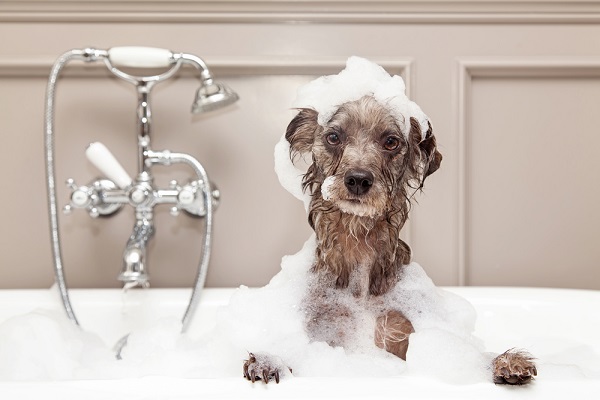
Everyone knows how to give a bath to an able-bodied dog, but do you know the techniques about bathing a paralyzed dog? Placing an animal in a tub of water when they can’t sit or stand on their own, makes the job tricky unless you know the safety techniques.
Even if your fur kid goes to a groomer, you’re likely to encounter an occasional late-night accident, if the dog is disabled or incontinent.
I know from personal experience there will be mishaps. I called myself “master of the 2 a.m. shower” during my dog’s illness. There were nights when Sophie slept so soundly, she didn’t realize she had rolled into her own mess. At those times, I would grab her bath towel and gently wake her up for a quick shower.
I learned to bathe Sophie through trial and error, but with the list of strategies below you’ll be prepared to do it right, the first time.
Note: This post contains affiliate links. Please read my disclosure policy for details.
More frequent baths for dogs that can’t walk

In addition to having accidents, paraplegic dogs in general require more baths. Their coat and paws get dirty from dragging themselves on the ground and their skin needs regular cleaning to prevent urinary tract infections and urine scald.
Most dogs adjust well to this new bathing schedule, especially if you make it a good experience and don’t scold them for having an accident. Our 2 a.m. shower time routine was inconvenient, but I would give anything to have those precious moments again with my girl.
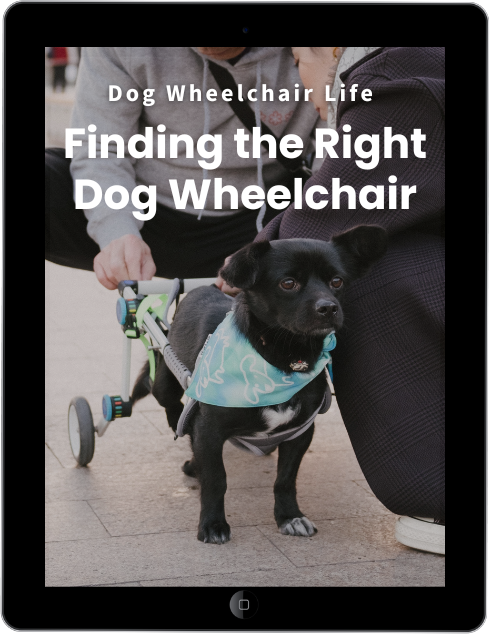
eBook
Find The Right Dog Wheelchair For Your Pet
Your dog has a mobility problem, and you want to buy a wheelchair. But do you know what kind of cart will work best for your dog’s individual needs? After a decade of teaching pet owners how to make the right choice, I put the information into an eBook!
Products to have on hand when bathing a paralyzed dog
Talk with your vet about these products to be sure they’re right for your pet.
Baby Wipes – Wipes are great to have on hand for quick cleanups. Make sure they’re fragrance-free, alcohol-free and made for sensitive skin.
Dry Shampoo – A dry shampoo made especially for a dog can be helpful for spot cleaning. Look for a product with natural ingredients. Dry shampoos can be found in pet supply stores.
Fluffy Towels – Have an assortment of clean, soft, fluffy towels designated for your dog’s use only. Be sure to have sizes that range from washcloths for small cleanups to bath towels. Wash the towels after every use with a gentle detergent.
Dog Shampoo – Make sure you buy a gentle shampoo that’s made strictly for canines. Look for one with natural ingredients and no preservatives. Some pet owners also use a gentle human shampoo called Maleseb which is used in nursing homes for the elderly.
Moisturizing Conditioner – If dry skin becomes a problem due to frequent baths, a moisturizing conditioner made for dog’s skin can be found at your veterinarian’s office or where specialty products are sold.
Other helpful products
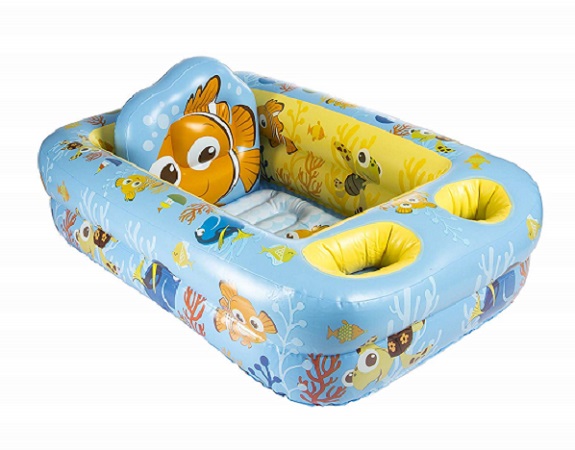
Barrier Cream – These are creams commonly used for diaper rash in babies. They can help keep your dog’s skin dry if an accident happens. Be sure the product Does Not Contain – Zinc Oxide which is toxic if licked by a dog.
Baby Powder – Powders are another way to keep your dog’s skin dry. Be sure to find one made from natural ingredients like cornstarch and Does Not Contain – Talc.
Wash Tub – If your dog is too small to fit safely in the bathtub, you can wash them in a sink or buy a dog bathtub with a non-slip bottom. Even a small unused litter box can serve as a portable tub.
Handheld Bathtub Sprayer for Pets– A portable hose that hooks up to the faucet of a tub or sink lets you direct where the bathwater will go. In a pinch you can also use a small plastic bowel or bucket.
A Stool to Sit On – The best technique might be to get into the tub or shower with your pup. A small stool will give something to sit on and you can position your dog between your legs for added security.
Step-by-step bathing instructions
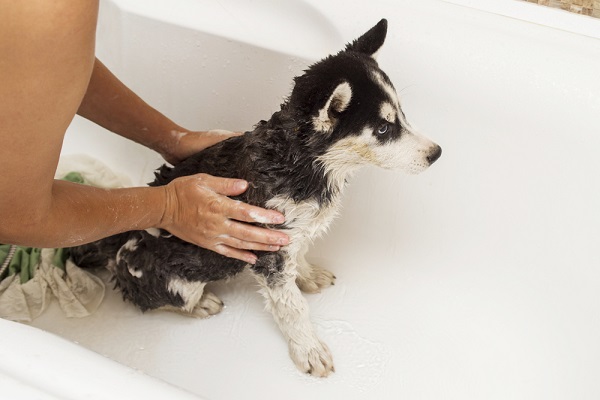
Gently place your dog into the tub – This might seem like ridiculous to point out, but a paralyzed dog’s hind legs are dead weight. Your dog has no way of helping you get into the bathtub. The bottom of a tub is hard so they can injure their legs or tail if they aren’t gently supported and placed into the tub. Try adding a big cushy foam bathmat to give your pup a softer and more secure experience.
Get into a secure position – Place the dog in a comfortable seated position in the bathtub. Make sure they’re steady and protected from falling into the water. A paralyzed dog may not be able to push their face out of the water if they fall on their side or are allowed to slide down. Some dogs do well with their legs pointed in front of them, some can be seated on their side or lie down and others are most steady when placed in a baby tub ring or other portable tub.
Keep the water temperature tepid and the level low – Your paralyzed dog won’t be able to react if the water is too hot. Paraplegic pets can’t feel the water temperature so it’s up to you to keep it tepid or lightly warm to the touch. Keep the water level low or about to your dog’s hip when he’s seated to prevent a possible drowning.
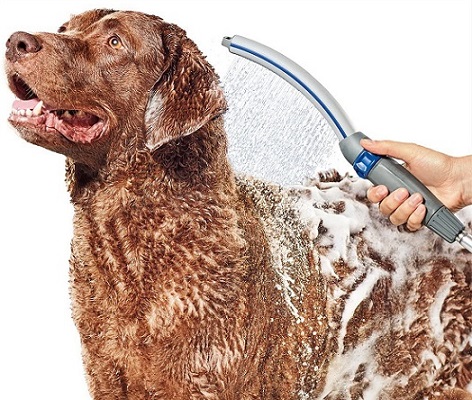
More steps
Start by washing at your dog’s face – Groomers suggest you start the bath time procedure by wetting your dog’s face, without getting too much water on the head or nose, and then gently massage in the shampoo. Move your hands in the same direction as your dog’s fur and work your way over their body. When you come to the belly, hind legs and tail; gently lift the dog to clean the area while supporting their body and then place the dog back down gently into their secure position.
Rinse and remove – Lightly rinse off all of the shampoo using a handheld sprayer and place several fluffy towels on the bathroom floor. Support your dog’s body as you lift them out of the water and onto the towels. Remember your paralyzed dog cannot assist you with this procedure so be sure to hold the body and hind legs until your dog is lying on the ground. Use as many fluffy towels as needed to pat your dog dry.
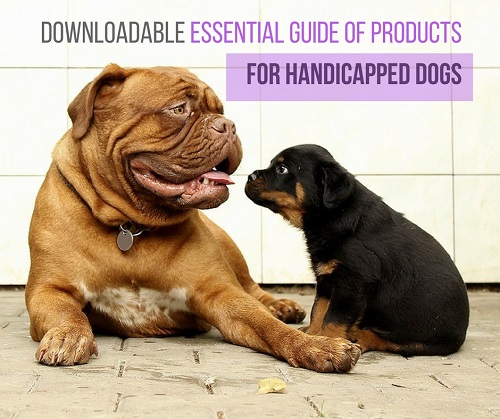
Get the Essential Guide
The Essential Guide of Products for Handicapped Dogs e-book is a labor of love for me. I wrote it to answer your most pressing questions about where to find the best products for your wheelchair dog. You’ll find products you didn’t know existed and each will improve your dog’s quality of life. Print a copy and keep it by your side.
Pet owners share their tips
Pet mom Carina T. uses this innovative way to bathe, Lola, her paralyzed West Highland terrier.
First, Carina’s fiancé sits on a step stool in the tub behind Lola. Then he positions his feet on either side of the dog to support her balance. This leaves his hands free to lather and bathe Lola. I think this is a pretty clever technique!
Another pet owner wrote to say that she bathes her dog outdoors, while he’s standing in his dog wheelchair.
This way, the pet mom doesn’t have to hold her up or help him keep his balance in a tub. She simply holds onto the leash with one hand and washes the dog with the other. It’s a brilliant idea, especially if you live in a warm climate where your dog will dry off quickly.
Disclaimer: I am not a veterinarian, so please check with your dog’s personal vet before implementing these bathing techniques.


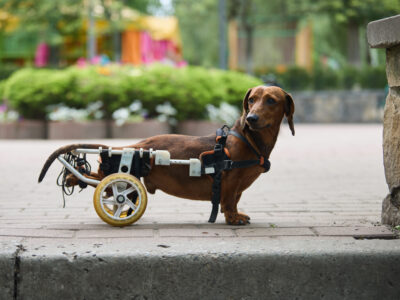
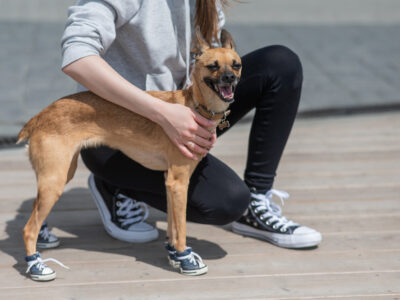

My pup is 17 lbs so it makes the most sense to shower with her in my arms. It’s much like what I imagine new parents might do with their babies. There is an awkward moment when I have to get out to dry her off and then get back in to rinse all her fur off me, but its much less stressful for her than the other methods we’ve tried. I put down several towels right outside the shower so she has somewhere soft and padded to rest while I wrap up my shower. I always throw the whole lot into the laundry afterwards. She struggles with ear infections from the water exposure as well, so I also make extra sure to dry her ears off too (usually blotting gently with cotton balls).
Andie, It sounds like you came up with a good plan for bathing your dog. I’m always amazed at how creative pet owners are in solving challenges like this and you’ve done a good job. Your pup is lucky to have you. – Sharon
My pup is 17 lbs so it makes the most sense to shower with her in my arms. It’s much like what I imagine new parents might do with their babies. There is an awkward moment when I have to get out to dry her off and then get back in to rinse all her fur off me, but its much less stressful for her than the other methods we’ve tried. I put down several towels right outside the shower so she has somewhere soft and padded to rest while I wrap up my shower. I always throw the whole lot into the laundry afterwards. She struggles with ear infections from the water exposure as well, so I also make extra sure to dry her ears off too (usually blotting gently with cotton balls).
Andie, It sounds like you came up with a good plan for bathing your dog. I’m always amazed at how creative pet owners are in solving challenges like this and you’ve done a good job. Your pup is lucky to have you. – Sharon